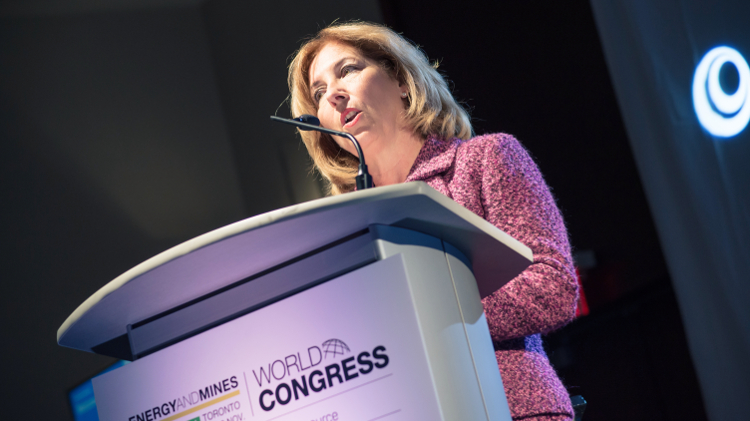The June 17 press conference where the Tailings Technology Challenge was launched. Left to right: Anders Nygren, dean of the Schulich School of Engineering at the University of Calgary; Kendall Dilling, president of the Pathways Alliance; Justin Riemer, CEO of Emissions Reduction Alberta; and Rebecca Schulz, Alberta’s minister of Environment and Protected Areas. Courtesy of Emissions Reduction Alberta via X
Alberta’s oil sands surface mining industry is entering an important phase in how it approaches one of its complex environmental challenges: the accumulation of water in tailings ponds.
Unlike other types of mining operations in Canada, there are currently no regulations that authorize the release of treated mine water (known as effluent) from oil sands mines into the environment. This means that oil sands mines have to retain the water used in their processes—as well as any water that accumulates on site, such as precipitation—and store it in tailings ponds.
According to the Mining Association of Canada, “dewatering is necessary to be able to reclaim most tailings facilities at oil sands mines, but that water can only be removed if it can be treated for safe release to the environment.”
An October 2024 report by the Alberta Energy Regulator (AER) revealed that in 2023, tailings ponds at the province’s oil sands mines contained 1.486 billion cubic metres of fluid tailings and 391.1 million cubic metres of water.
“For almost 50 years, oil sands operators have been forced to retain most of the water they use, leading to billions of litres stored, largely in tailings ponds. Collecting more and more water with no end in sight is not sustainable,” said Rebecca Schulz, Alberta’s minister of Environment and Protected Areas, at a press conference on June 17. “It not only creates environmental and financial liabilities, but it takes water permanently out of the system, preventing it from being used by others who need it. While the industry continues to wait for a treat and release regulation from the federal government, we cannot wait to address this issue.”
While both the federal and Alberta governments share responsibility for decisions regarding the treatment and release of oil sands mine water (OSMW), specific regulatory requirements are still under development. The federal government is assessing options through the Crown-Indigenous Working Group for the Potential Oil Sands Mining Effluent Regulations, which was established by Environment and Climate Change Canada and nine Indigenous communities in January 2021, and expects to complete a draft regulatory framework by the end of this year.
Alberta’s approach
The province’s Ministry of Environment and Protected Areas established an Oil Sands Mine Water Steering Committee (OSMWSC) in May 2024 to assess all feasible options for safely managing the water in oil sands tailings ponds and speeding up tailings pond reclamation. The committee—which includes representatives from Indigenous and local communities, the oil sands mining industry, as well as tailings and academic experts—spent a year reviewing relevant research and engaging with industry operators, technology providers, Indigenous community members, academics and scientists to consider various perspectives and potential solutions.
On June 12, the committee released its first five recommendations to the provincial government, which mainly focused on management aspects such as improving the efficiency of water use, developing new measurement standards and managing or reducing water accumulation at mine sites.
“Navigating the technical complexities of oil sands mine water and tailings requires careful consideration of many viewpoints,” wrote Tany Yao, chair of the OSMWSC and MLA for Fort McMurray-Wood Buffalo, in a letter accompanying the recommendations. “However, inaction is a choice that will not only enlarge these water bodies but also place an increasing burden—environmental and economic—on the Albertans of today and tomorrow.”
In the next six months, the Ministry of Environment and Protected Areas will work with the AER and others “to evaluate and explore these recommendations to put a plan in place that is realistic, safe and backed by research and evidence,” a June 12 provincial government press release said.
Schulz mentioned at the press conference that the ministry had been talking to the oil sands industry about the best ways to implement the recommendations. “Industry has been very willing to step up to address this problem in a proactive and positive approach,” she said. “I’m pretty encouraged by the conversations I’ve had, not only with Pathways [Alliance, a consortium of Canada’s six largest oil sands producers], but with the individual companies as well, and I think the work of the committee is going to be really helpful in moving this forward.”
Meanwhile, the committee is continuing its work and plans to release further recommendations in the near future.
Recommendation 1: Non-process-affected water (on-site water not directly used in oil sands extraction or separation processes including rainwater, melting snow and surface runoff) at oil sands mines should be segregated from process-affected water, and the provincial government should create clearer standards for this water’s safe release into the environment.
Keeping the water streams separate would allow non-process-affected water to be repurposed for operational use, which would decrease the amount of fresh water being withdrawn from the Athabasca River. It would also reduce the amount of water directed to tailings ponds.
The committee acknowledged that some oil sands operators are already recycling non-process affected water for operational use; for example, Suncor Energy has achieved on-site internal water recycling rates of above 90 per cent.
Recommendation 2: The government should update its policies and processes to encourage more sharing of water resources between oil sands operations, which would also optimize water usage and reduce the overall demand for water from the Athabasca River. The committee stated that water sharing could be particularly beneficial for operators that have both mining and in-situ operations in close proximity.
Recommendation 3: The government should prioritize local utilization and management of OSMW within the Lower Athabasca sub-watershed, where the oil sands are located. The committee noted that transferring OSMW to other sub-watersheds, or out of the Athabasca River watershed to be used by other sectors in the rest of the province, could present environmental challenges and would be a more expensive option than treating the water and re-using it locally.
Recommendation 4: The government should consider deep-well disposal (injecting OSMW into underground geological formations, beneath multiple layers of impermeable rock that keep it away from sources of drinking water) as an option to manage low volumes of economically untreatable OSMW as well as some legacy mine water. However, the committee stated that deep-well disposal should not be a primary solution to manage accumulated OSMW, and that there should be regulatory limits on the volume of water that can be injected. It cited just two circumstances where deep-well disposal should be considered for open-pit mines: to manage economically untreatable streams of OSMW; and to manage accumulated OSMW while water release standards are being developed, if all other management options have been considered already.
Recommendation 5: The government should establish standardized measurement methods for naphthenic acids (NAs), which are a diverse group of naturally occurring complex organic compounds found in OSMW that pose significant environmental and regulatory challenges.
Since there is no guidance on NAs from other jurisdictions that could be adopted in Alberta, the committee proposed that the government should take the lead in identifying and developing standardized methods for measuring them. It also suggested that high-resolution mass-spectrometry standardized methods could offer the most accurate and reliable approach.
The Tailings Technology Challenge
On June 17, Emissions Reduction Alberta (ERA) launched a competition called the Tailings Technology Challenge to align with the OSMWSC’s initial recommendations. ERA has committed up to $50 million to the challenge, which will be funded through the Alberta government’s Technology Innovation and Emissions Reduction (TIER) regulation, to support the development and improvement of technologies and solutions to help to reduce and manage OSMW.
Successful submissions to the competition can receive sums of between $1 million and $15 million per project, covering up to 50 per cent of a project’s cost.
The eligibility criteria are not technology prescriptive, but ERA’s guidelines stated that “all proposed solutions must focus on tailings and/or water management and must demonstrate a clear line of sight towards realized benefits through the project.” Examples of project areas that would align well with the challenge include those focusing on tailings dewatering and volume reduction, water treatment technologies, innovative methods to reduce waste generation or solutions that can recover value from OSMW.
The challenge is open to oil sands operators and technology providers. “This new funding will help us develop smarter, safer and more effective ways to reduce tailings ponds and ultimately reclaim the land,” said Schulz at the press conference. “The competition is open to operators of all sizes and technologies at all stages, with a focus on those that can help minimize freshwater use, treat and reclaim processed water and close sites responsibly. By upgrading our technology, we can help protect communities and the environment downstream, lower cleanup costs and keep industry globally competitive.”
According to Justin Riemer, chief executive officer of ERA, applicants are “strongly encouraged” to partner with post-secondary and research institutions, Indigenous communities and municipalities and will have to prove they have a “strong partnership” with an existing oil sands operator to be eligible.
Kendall Dilling, president of the Pathways Alliance, praised the challenge at the press conference, pointing out that advancing technologies through the funding will add to the knowledge and expertise that the oil sands industry has already developed in this area.
The deadline for applications to the challenge was in September, and funding notifications are expected to take place in January 2026.




